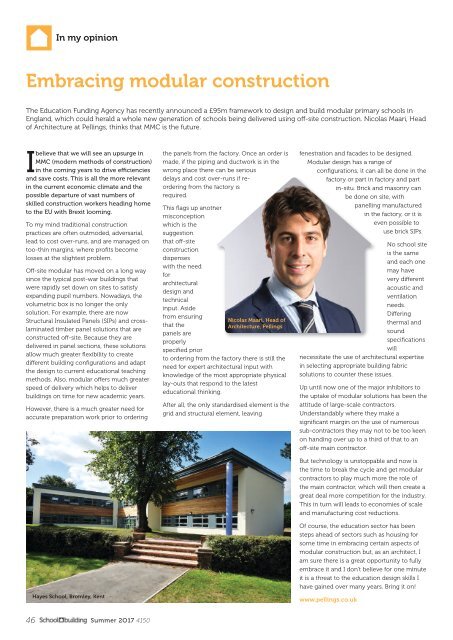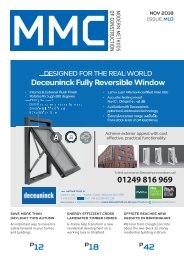SB 4150 Web
Create successful ePaper yourself
Turn your PDF publications into a flip-book with our unique Google optimized e-Paper software.
In my opinion<br />
Embracing modular construction<br />
The Education Funding Agency has recently announced a £95m framework to design and build modular primary schools in<br />
England, which could herald a whole new generation of schools being delivered using off-site construction. Nicolas Maari, Head<br />
of Architecture at Pellings, thinks that MMC is the future.<br />
Ibelieve that we will see an upsurge in<br />
MMC (modern methods of construction)<br />
in the coming years to drive efficiencies<br />
and save costs. This is all the more relevant<br />
in the current economic climate and the<br />
possible departure of vast numbers of<br />
skilled construction workers heading home<br />
to the EU with Brexit looming.<br />
To my mind traditional construction<br />
practices are often outmoded, adversarial,<br />
lead to cost over-runs, and are managed on<br />
too-thin margins, where profits become<br />
losses at the slightest problem.<br />
Off-site modular has moved on a long way<br />
since the typical post-war buildings that<br />
were rapidly set down on sites to satisfy<br />
expanding pupil numbers. Nowadays, the<br />
volumetric box is no longer the only<br />
solution. For example, there are now<br />
Structural Insulated Panels (SIPs) and crosslaminated<br />
timber panel solutions that are<br />
constructed off-site. Because they are<br />
delivered in panel sections, these solutions<br />
allow much greater flexibility to create<br />
different building configurations and adapt<br />
the design to current educational teaching<br />
methods. Also, modular offers much greater<br />
speed of delivery which helps to deliver<br />
buildings on time for new academic years.<br />
However, there is a much greater need for<br />
accurate preparation work prior to ordering<br />
Hayes School, Bromley, Kent<br />
the panels from the factory. Once an order is<br />
made, if the piping and ductwork is in the<br />
wrong place there can be serious<br />
delays and cost over-runs if reordering<br />
from the factory is<br />
required.<br />
This flags up another<br />
misconception<br />
which is the<br />
suggestion<br />
that off-site<br />
construction<br />
dispenses<br />
with the need<br />
for<br />
architectural<br />
design and<br />
technical<br />
input. Aside<br />
from ensuring<br />
that the<br />
panels are<br />
properly<br />
specified prior<br />
Nicolas Maari, Head of<br />
Architecture, Pellings<br />
to ordering from the factory there is still the<br />
need for expert architectural input with<br />
knowledge of the most appropriate physical<br />
lay-outs that respond to the latest<br />
educational thinking.<br />
After all, the only standardised element is the<br />
grid and structural element, leaving<br />
fenestration and facades to be designed.<br />
Modular design has a range of<br />
configurations, it can all be done in the<br />
factory or part in factory and part<br />
in-situ. Brick and masonry can<br />
be done on site, with<br />
panelling manufactured<br />
in the factory, or it is<br />
even possible to<br />
use brick SIPs.<br />
No school site<br />
is the same<br />
and each one<br />
may have<br />
very different<br />
acoustic and<br />
ventilation<br />
needs.<br />
Differing<br />
thermal and<br />
sound<br />
specifications<br />
will<br />
necessitate the use of architectural expertise<br />
in selecting appropriate building fabric<br />
solutions to counter these issues.<br />
Up until now one of the major inhibitors to<br />
the uptake of modular solutions has been the<br />
attitude of large-scale contractors.<br />
Understandably where they make a<br />
significant margin on the use of numerous<br />
sub-contractors they may not to be too keen<br />
on handing over up to a third of that to an<br />
off-site main contractor.<br />
But technology is unstoppable and now is<br />
the time to break the cycle and get modular<br />
contractors to play much more the role of<br />
the main contractor, which will then create a<br />
great deal more competition for the industry.<br />
This in turn will leads to economies of scale<br />
and manufacturing cost reductions.<br />
Of course, the education sector has been<br />
steps ahead of sectors such as housing for<br />
some time in embracing certain aspects of<br />
modular construction but, as an architect, I<br />
am sure there is a great opportunity to fully<br />
embrace it and I don’t believe for one minute<br />
it is a threat to the education design skills I<br />
have gained over many years. Bring it on!<br />
www.pellings.co.uk<br />
46<br />
Summer 2O17 <strong>4150</strong>
















